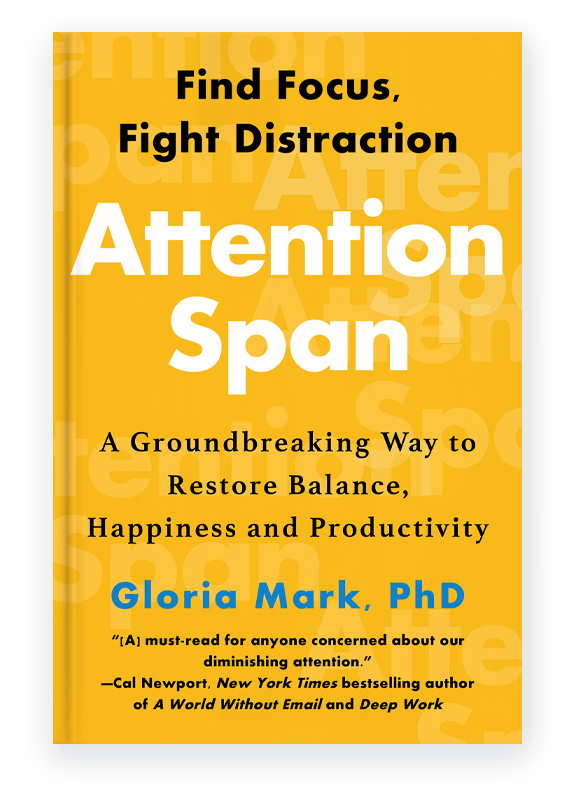Attention Span
A Groundbreaking Way to Restore Balance, Happiness and Productivity
Rediscover your ability to pay attention with this groundbreaking new approach from “the definitive expert on distraction and multitasking” (Cal Newport). Read more.
BUY NOW

My research over nearly two decades shows that our attention spans are declining, averaging just 47 seconds on any screen. This is alarming. But it does not mean we are doomed to live unfocused lives.
We are experiencing a fundamental shift in how we think, how we work, how we focus, and how we achieve fulfillment. We can all feel it—in our burnout, Zoom fatigue, endless notifications, and our inability to maintain our attention. Technology has been designed with the intent to augment our capabilities and help us produce more, but we are also distracted and exhausted in our everyday use with it. It might feel like we are losing our ability to focus entirely, but there is some good news. Our ability to focus isn’t lost, the way we focus is just changing.
Based on decades of original research in what I call “living laboratories”, where I study technology use in people’s real world environments, this book not only presents the science of exactly how short our attention spans have become, how much we’re interrupted and how much stress that causes us, but also how we can gain control of our attention and achieve wellbeing.
In Attention Span, I begin by debunking four popular myths about our attention and technology.
The first myth is that we should always strive to be focused, and should feel guilty if we can’t. But, just as we can’t lift weights nonstop for long periods of time, we also can’t hold sustained focus for long stretches—in both cases, you’re going to need to rest at some point to replenish your resources.
My research shows that we have different types of attention—some that tax us like lifting weights, and some that replenish us like a rest between sets—and those types of attention follow a rhythm. Rather than chasing the myth of unbroken focus, each of us needs to instead learn to follow our own rhythms of our attentional peaks in order to feel healthy and productive.
The second myth is that the rote, mindless activity that we do on our computers and phones is wasteful of our time (think of Candy Crush). It turns out that mindless activities like playing simple games doesn’t just make us temporarily happy, when used strategically those activities can also help us replenish our overspent mental resources, and enable fresh ideas to surface.
A third myth is that our distractions and inability to focus on our devices are due primarily to notifications overload and our own lack of discipline. But it’s more complicated than that. There are a number of underlying sociotechnical forces that lead us to be distracted. Beyond what we all think we know about targeted algorithms and tailored advertising, the design of the internet itself, and the daily hours we are exposed to seemingly unrelated media like TV, film, advertising, and music videos, with their fast-paced changing shots (which, like our attention spans, have been getting shorter and shorter), also affect our ability to focus.
The number of factors at play when it comes to managing focus are as diverse as our unique lives. We are endlessly swayed by things like the desire to maintain social capital and influence, or emotional rewards, and even our own unique personality types can render us more or less susceptible to distraction.
Finally, the fourth myth is that the much popularized idea of flow is the ideal state we should strive for when we use our technologies. Rather than trying to achieve flow, which is simply not realistic for the nature of most of our jobs, which require an analytical mindset, our goal instead should be to achieve a balance of different types of attentional states.
Ultimately, Attention Span presents an optimistic vision. The goal of this book is to reframe the singular goal of maximizing our productivity, to instead achieve a broader goal of how we can live with and use our technologies and maintain a healthy psychological balance. And yes, we’ll be productive along the way. We can learn to adapt to our own rhythms of attention—finding focus, fighting distraction, and ultimately feeling more balanced and less stressed in our daily lives. The ship has sailed: we live in an interconnected world and need to use our devices—but we can also achieve well-being while doing so.